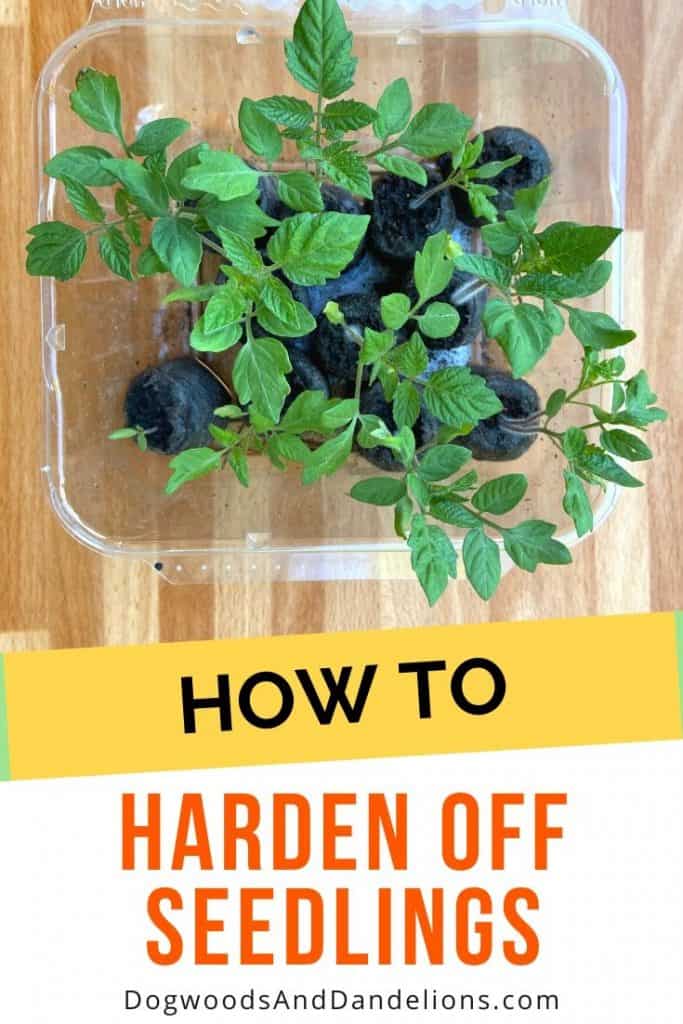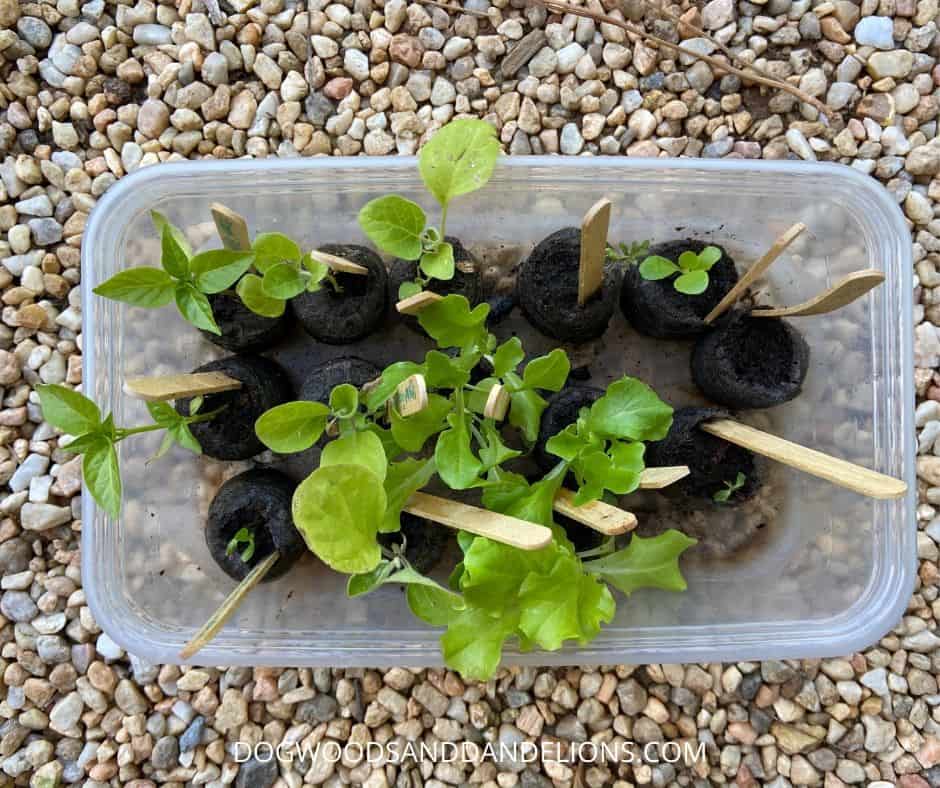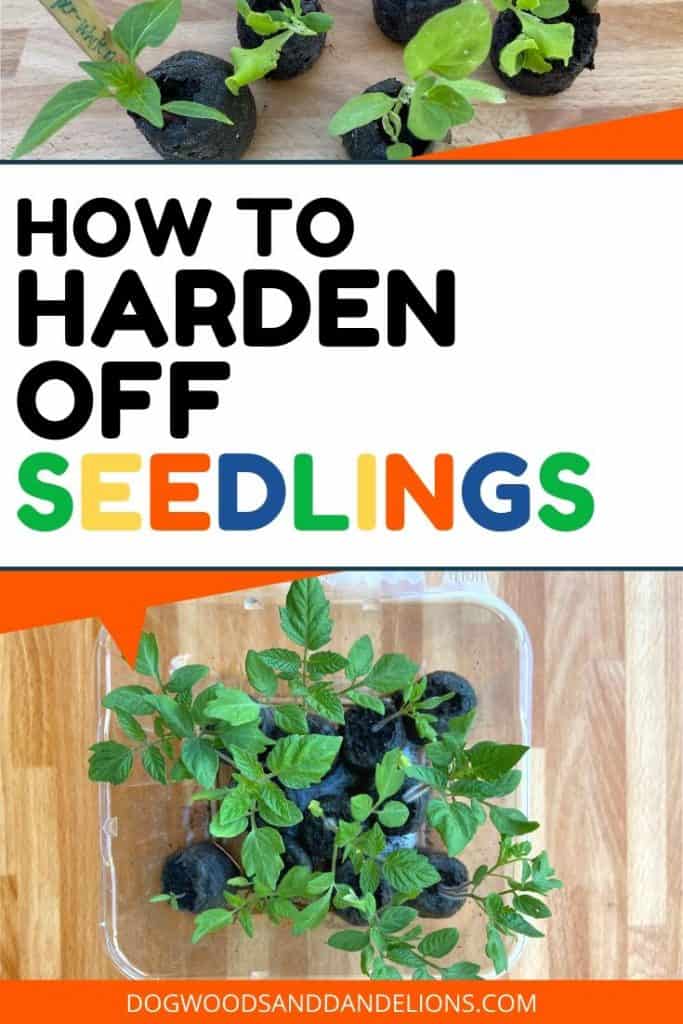How to Harden Off Seedlings
Inside: Learning how to harden off seedlings is important to ensure success when you transplant seedlings into the garden.
Spring has come and your new little seedlings are doing well under their grow lights. Your last expected spring frost date has come and gone.
You are ready to put those plants in the garden. But wait! Have you hardened off those little seedlings? If not, those plants you worked so hard to grow may have a difficult time acclimating to the garden.
Let’s look at what hardening off seedlings means, why you should do it, and how to harden off seedlings.

Affiliate Disclosure: Please note that some of the links in this article may be affiliate links and I may receive a small commission if you purchase something through a link. It will not change your cost. As an Amazon Associate, I earn from qualifying purchases. For more information, see my disclosures page.)
What Does It Mean to Harden Off Seedlings?
Your seedlings that have been grown indoors are used to a comfy, cozy life. There are no fluctuating temperatures. No pouring rain. No windy conditions to battle. They’ve had a good and easy life.
If you immediately move them outdoors to face all the elements, they will experience transplant shock. Think about how you feel when going from a freezing air-conditioned building in the summer to the outdoors on a 90-degree day. It’s quite a shock to your system too.
Hardening off seedlings is how we help the plants adapt to the environment gradually. They get used to the elements – wind, rain, bright sun, and fluctuating temperatures in small increments so they are more prepared when you plant them in your backyard garden.

Why Do You Need to Harden Off Seedlings
If you immediately place seedlings outdoors there are several things that can happen that will weaken your plants. First, if it is sunny, the sunlight can burn the leaves of the plant. This usually appears as white patches on the leaves.
If it is breezy, the wind can dry out the plants and even break the stems. Most plants kept indoors aren’t used to much movement unless you’ve been running a fan near your seedlings.
Finally, moving plants to the outdoors can mean it is too hot during the day and too cold at night. Indoors your plants were probably used to a fairly steady temperature throughout the day and night. Once you plant them outside they are subjected to wildly fluctuating temperatures every day.
How to Harden Off Seedlings
Acclimating our seedlings to the outdoors is best done gradually. You will need to allow one week for the process, but two weeks is even better.
This needs to be done for both cool-season and warm-season vegetables. However, with warm-season crops, you need to first find your last expected frost date so you know when it is time to start hardening off your seedlings.
Warm-season vegetables can’t handle any frost, so they shouldn’t start the hardening-off process more than 2 weeks before your last expected frost.
Once you start the process, you will still need to pay close attention to the weather forecast so that you don’t put frost-sensitive plants out on a cold morning. Below is an easy way to harden off plants so they are ready for the garden.

Prepare Your Seedlings for the Outdoors
Days 1 and 2: Place plants outdoors in a shaded location out of the wind for about 2 hours. Bring them back inside afterward and put them back under the grow lights.
Days 3-4: Add another hour or two each day outdoors with the plants in a sheltered location.
Days 5-6: Place plants outdoors again, for 4 to 6 hours in a sheltered location. Move plants into the sunshine for about one hour, preferably in the morning or evening. Continue bringing them in and returning them to their grow lights for the remainder of the day.
Days 7+: Allow the plants to stay outdoors in a sheltered location, adding about 2 hours each day. Move them into the sun for increasingly longer periods of time. Ensure they have adequate moisture before moving them into the sun. However, don’t get water on the leaves and then place them in the sunlight. The water on the leaves will amplify the sun’s rays and can burn the leaves.
Two to three days before you plan to plant the seedlings in your garden, leave the plants out overnight. Double-check the weather forecast to ensure overnight lows won’t drop below 40 degrees.

Note: While I realize that 32 is freezing, many times depending on your microclimate, areas especially away from the city can drop below what is forecast. We have often had forecasted lows of 39, yet have had frost on the ground the next morning. When you work hard to raise transplants, the last thing I want to happen is for you to lose them to a frost as you are trying to harden them off.
While this schedule doesn’t have to be followed strictly, it does give beginning gardeners an idea of how to best harden off seedlings to avoid transplant shock.
When You Are Ready To Plant
When you are finally ready to plant your seedlings in the garden, plant on a cloudy day if possible. However, don’t plant on a day when the forecast calls for heavy rain.
If you can’t plant on a cloudy day, at least try to avoid planting on an unusually hot day. Water your plants well at the soil level so you don’t burn the leaves and check on your newly planted transplants each day to see if they need to be watered.
By using these tips, you should be able to successfully prepare your seedlings for the outdoors and plant them in the garden with minimal transplant shock.
Related Posts
- Tips and tricks to get your garden started earlier
- Vegetables you can grow in the shade
- What to direct sow vs. what to plant as transplants

Meet Julie
I’m a farm girl born and bred in North Carolina. I’ve been growing a vegetable garden for over 20 years (and helping my Mom grow hers even longer). I’ve been raising chickens in my bathtub and backyard for 12+ years. I believe that homegrown food can be made simple. Let’s get started.


Happy to have seen this post. My seedlings did go into shock and died. Had to start over anew. Thanks! Will be trying your method.
I hope this method works well for you. Thanks for commenting.